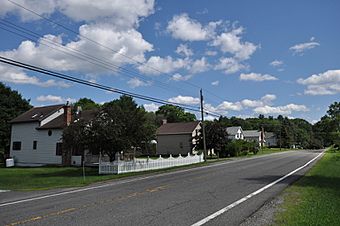Richmond Furnace Historical and Archeological District facts for kids
Quick facts for kids |
|
|
Richmond Furnace Historical and Archeological District
|
|

A row of former worker housing on Route 41
|
|
| Location | State, Cone Hill, and Furnace Rds., Richmond, Massachusetts |
|---|---|
| Area | 290 acres (120 ha) |
| Built | 1763 |
| Architect | Bartram, I.N., & Co.; Richmond Iron Works Co. |
| Architectural style | Federal, Greek Revival |
| NRHP reference No. | 99001044 |
| Added to NRHP | August 31, 1999 |
The Richmond Furnace Historical and Archeological District is a special place in Richmond, Massachusetts. It's a historic area where people used to make iron a long time ago. This industrial site began in 1763 with simple grist and sawmills.
Later, in 1829, the first stone furnace was built here. This furnace was used to make iron from a type of rock called hematite, which was found nearby. The furnace was updated in 1863 and again in 1905 to make even more iron. Iron production continued in this area until 1923.
The district also includes old houses and other buildings that were part of the iron-making business. Because of its important history, the area was added to the National Register of Historic Places in 1999.
What Does the District Look Like?
The Richmond Furnace district is in the southern part of Richmond. Today, it's mostly a quiet, rural area. It covers about 290 acres (120 ha), which is like 290 football fields! The area is shaped a bit like the letter "L".
The longer part of the "L" follows Furnace Brook, a small stream that flows south. Most of the old industrial buildings and remains are on the east side of this brook. You can find them between Furnace Pond and areas south of Furnace Road.
The main furnace is on private land, near Furnace Lane and the brook. The shorter part of the "L" stretches east from here. It includes more old houses and industrial remains. One cool feature is a water-filled quarry on the north side of Furnace Road.
Further east, on Cone Hill Road, you'll find more houses where workers used to live. There's also the Cone Hill Cemetery, where many people connected to the iron works are buried. You can see surviving homes for both workers and managers on most of the roads in the district.
A Look Back at the Iron Works
The Richmond Iron Works was started in 1829 by three brothers: John H., Charles, and George Coffing. They had learned about making iron at the Salisbury Iron Works in nearby Connecticut.
In 1834, the company built a second furnace. This one was in Van Deusenville, a part of Great Barrington. By 1855, the company was using 9,000 tons of iron ore to produce 3,200 tons of iron. That's a lot of iron!
The furnace in Van Deusenville worked until 1896 and was taken apart in 1906. By 1908, the Richmond site could produce 5,000 tons of iron each year. This iron was used to make things like car wheels and parts for machines. At that time, the main furnace was about 33 feet tall and 9.5 feet wide at its base.
Images for kids




